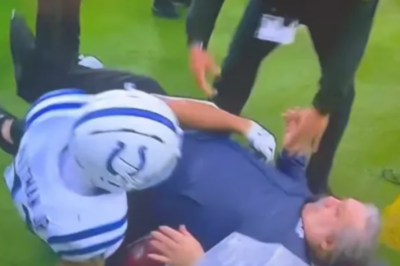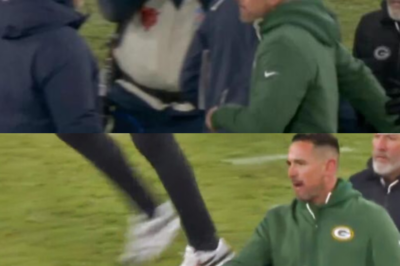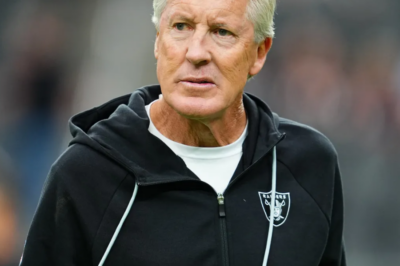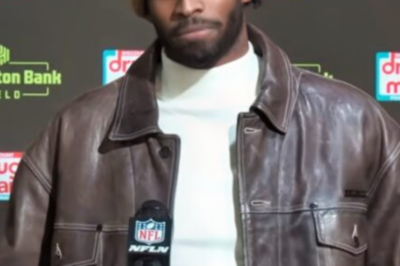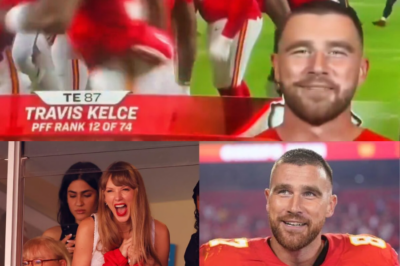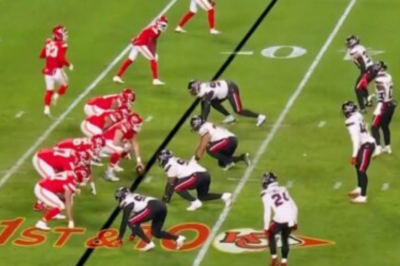BANNED FROM THE SUPER BOWL? Viral video of Bad Bunny’s “God Bless America” snub sparks national outrage and could cost him the Halftime Show. The clip that started it all.
In the hallowed, history-steeped cathedral of American sport that is Yankee Stadium, certain rituals are as immutable as the iconic white facade and the monument park beyond the center-field wall.
The seventh-inning stretch is one such tradition, a collective, unifying pause in the tension of competition. It is during this interlude that the familiar, stirring chords of “God Bless America” often resonate through the stands, a moment intended for patriotic reflection and communal respect.
It was within this precise context, during the high-stakes American League Division Series (ALDS), that global megastar Bad Bunny, born Benito Antonio Martínez Ocasio, became the eye of a cultural hurricane.
Multiple fan-recorded videos from that October evening captured a seemingly simple, yet profoundly potent, image: as thousands of fans, Yankees players, and stadium staff rose to their feet, Bad Bunny remained seated.
This single act of non-participation, lasting little more than a few minutes, has since detonated across the digital and traditional media landscape, igniting a fierce and multifaceted debate that stretches far beyond the baseball diamond.
The controversy has since fused with another looming cultural event—the Super Bowl 60 Halftime Show—for which Bad Bunny is a rumored top contender.
This confluence has transformed a moment of personal choice into a high-stakes national conversation, forcing an examination of patriotism, celebrity influence, artistic expression, and the very nature of the platforms we consider quintessentially American.
This article will provide a comprehensive, in-depth analysis of this ongoing event, tracing its origins, deconstructing the polarized reactions, exploring the historical context of anthem protests, and examining the significant commercial and reputational implications for both the National Football League and the artist himself as the drumbeat to ban him from the Super Bowl grows louder.
The Incident at Yankee Stadium – A Frame-by-Frame Account and Immediate Aftermath
To understand the scale of the reaction, one must first appreciate the setting and the players involved. The ALDS represents the pinnacle of the baseball postseason, where every pitch is magnified, and every fan’s energy is electric.
Bad Bunny, a native of Puerto Rico, was not merely a casual attendee; he is arguably the most successful and influential Latin artist in the world, a figure whose every move is documented by an army of fans and paparazzi. His presence at the game was itself a news story.
The Video Evidence:
The evidence itself is raw and citizen-journalist in nature: shaky smartphone footage, often zoomed in from various angles throughout the stadium.
The videos clearly show the stadium announcer likely requesting the crowd to stand for the performance of “God Bless America.” A wave of people rises to their feet, a sea of navy and white Yankees jerseys.
The camera then finds Bad Bunny, often in the company of friends or associates, who remains seated. He does not appear to be engaged in conversation; he is not on his phone; he is simply observing, a picture of calm amidst a standing ovation. His expression is inscrutable—neither defiant nor dismissive, but passive and non-participatory.
The Immediate Digital Explosion:
In the age of instant dissemination, the videos did not simply go viral; they went supernova. Within hours, clips bearing captions like “BAD BUNNY DISRESPECTS AMERICA!” and “Shameful Behavior at Yankees Game” were trending across X (formerly Twitter), Instagram, and TikTok. The conversation immediately bifurcated into two entrenched camps.
This perspective, championed by conservative commentators, political figures, and a significant portion of the sports-viewing public, framed the act as a deliberate snub. The core of their argument hinges on the symbolic weight of “God Bless America.”
For many, the song is a stand-in for the national anthem, a tribute to the nation’s ideals, its military veterans, and its history. To remain seated is interpreted not as a personal choice, but as a public rejection of those values. Critics argued that as a guest in the country and at a cherished sporting event, a basic level of respect for the host nation’s traditions was required—a social contract they believe Bad Bunny blatantly violated.
Conversely, defenders of the artist, including his massive fanbase (the “Conejos Malos”), free speech advocates, and cultural critics, pushed back vigorously. Their arguments were multifaceted: first, they noted that “God Bless America” is not the official national anthem of the United States (“The Star-Spangled Banner” is, and it is performed before the game).
Second, they emphasized the principle of individual autonomy—the right to choose whether or not to participate in a patriotic ritual. Many drew parallels to the foundational American right to peaceful protest, arguing that sitting silently is a form of expression protected by the very principles the song represents. Others pointed to Bad Bunny’s Puerto Rican heritage, suggesting that his relationship with the United States, as a citizen of a territory, is complex and inherently political.
Deeper Context – The Long and Contested History of Protest in American Sports
To view the Bad Bunny incident in a vacuum is to misunderstand its profound resonance. It is merely the latest chapter in a long and often painful history of athletes and entertainers using the sporting arena as a stage for social and political commentary.
The Precedents: From Smith and Carlos to Kaepernick
The most direct lineage traces back to the 1968 Mexico City Olympics, where American sprinters Tommie Smith and John Carlos raised black-gloved fists during the national anthem, a silent, powerful protest for human rights and against racial injustice. The backlash was swift and severe; they were suspended and ostracized, but their image is now enshrined as an iconic moment of moral courage.
This tradition was powerfully revived in 2016 when then-San Francisco 49ers quarterback Colin Kaepernick chose first to sit, and then to kneel, during the national anthem to protest police brutality and systemic racism.
The “Take a Knee” movement ignited a firestorm that continues to smolder. It divided the nation, drew the ire of a sitting president, and effectively ended Kaepernick’s NFL career, all while inspiring a global conversation about race, power, and patriotism.
The Shifting Terrain of Corporate and League Response
The Kaepernick saga forced every major sports league, including the NFL and MLB, to grapple with how to manage the intersection of sports and politics. For years, the NFL struggled with a public relations crisis, eventually implementing—and later walking back—policies regarding player conduct during the anthem.
The league has since attempted to straddle the line, promoting social justice initiatives while trying to avoid alienating any segment of its fanbase. The Bad Bunny incident reintroduces this tension, but with a key difference: the protagonist is not an employee of the league (a player), but a potential hired entertainer.
The Super Bowl Halftime Conundrum – A Collision of Commerce, Culture, and Controversy
This is where the narrative escalates from a sports controversy to a potential corporate crisis.
The Super Bowl Halftime Show is not just a musical interlude; it is the most-watched musical performance on the planet, a meticulously choreographed spectacle that serves as a cultural barometer. The selection of an artist is a multi-million dollar decision fraught with implications.
The Case for Bad Bunny as a Headliner
From a purely business and cultural standpoint, Bad Bunny is an undeniable, almost inevitable, choice for the NFL.
Global Dominance: He has consistently been the most-streamed artist globally on platforms like Spotify for multiple years, a testament to his unprecedented transnational appeal.
Demographic Reach: The NFL is in a perpetual quest to younger and diversify its audience. Bad Bunny’s immense popularity among Latino and Gen Z demographics represents a golden opportunity for the league to expand its footprint.
Spectacle and Showmanship: His concerts are known for their high-energy, visually stunning, and theatrically ambitious productions, perfectly suited for the Halftime Show’s demands for a massive, memorable spectacle.
The Mounting Pressure to Ban Him
However, the Yankee Stadium incident has thrown a wrench into this seemingly perfect match. The calls for his ban are not merely scattered social media complaints; they are being amplified by influential voices.
Political and Pundit Amplification: Prominent conservative commentators, talk radio hosts, and even some politicians have seized upon the issue, framing a potential Bad Bunny Halftime Show as the NFL “endorsing” anti-American sentiment. They have launched campaigns, using hashtags like #BanBadBunny and #NotOurHalftime, urging the league and its sponsors to reconsider.
The Sponsorship Factor: The Super Bowl is a commercial juggernaut powered by billion-dollar brands. These corporations are notoriously risk-averse. The fear for the NFL is not just public outcry, but the threat of sponsors getting cold feet, fearing a boycott from consumers who view the selection as a political statement. The league must perform a delicate calculus: will the audience Bad Bunny attracts be larger and more engaged than the segment he might alienate?
The Precedent of Past Cancellations: The NFL is acutely aware of past controversies. The 2004 “Nipplegate” incident with Janet Jackson and Justin Timberlake led to a massive FCC fine and a decade-long chilling effect on the show’s creative risks. While the nature of the controversy is different, the league’s institutional memory of backlash is long and deeply ingrained.
The Artist’s Silence and the Power of Narrative
A pivotal element of this ongoing drama is Bad Bunny’s own response, or rather, the lack thereof. The artist has made no public statement—no tweet, no Instagram post, no press release—addressing the Yankee Stadium incident. This silence is itself a powerful communication tool.
Strategic Ambiguity: By not explaining his actions, he prevents his critics from dissecting and dismissing a specific justification. It allows his supporters to project their own interpretations onto his silence, framing it as a dignified refusal to bow to manufactured outrage.
Maintaining the Brand: Bad Bunny has built his brand on authenticity and a certain rebellious, anti-establishment edge. To issue a contrite apology would be seen as inauthentic by his core fanbase. To offer a political explanation would fully politicize the event in a way he may wish to avoid. His silence can be read as a statement that his personal conduct is not up for public debate or required to meet public expectation.
Section 5: The Broader Implications – A Society at a Crossroads
The Bad Bunny anthem controversy is a microcosm of the larger cultural and political fissures defining the contemporary American experience.
The Evolving Nature of Patriotism: The debate forces a question: what does it mean to be patriotic in the 21st century? Is it the uncritical performance of ritual, or is it the exercise of the right to dissent in pursuit of a “more perfect union”? The incident highlights the starkly different answers to this question held by various segments of the population.
The Platform and the Performer: It raises questions about the expectations placed upon celebrities, particularly those of color, when they enter traditionally “mainstream” American spaces. Are they required to assimilate to the established norms of that space, or do they have the right to bring their full, complex identities and perspectives with them?
The Commercialization of Culture: Ultimately, the decision regarding the Super Bowl Halftime Show will be a masterclass in corporate risk assessment. It will reveal what the NFL values more: the explosive growth potential of a global superstar or the perceived stability of its traditional, and often more politically vocal, fanbase.
The Unresolved Finale Awaiting Super Bowl Sunday
The videos from Yankee Stadium have ceased playing, but the echo they have created is louder than ever. The image of Bad Bunny, seated in quiet contemplation, has become a Rorschach test for the nation’s feelings on patriotism, celebrity, and the price of protest. The controversy is no longer about a single moment during a baseball game; it is about the soul of America’s biggest cultural stages.
As the NFL’s executives undoubtedly deliberate behind closed doors, weighing focus group data, sponsor feedback, and social media metrics, the world watches. The decision they make regarding the Super Bowl 60 Halftime Show will be interpreted as a verdict on this entire affair. Will they view Bad Bunny’s act as a disqualifying disrespect or as an expression of personal liberty? Will they prioritize inclusion and growth, or will they yield to the pressures of a vocal minority?
The answer will not only determine the soundtrack to next year’s championship game but will also send a powerful message about who and what is welcome at the center of the American cultural tableau. The kickoff for Super Bowl 60 is months away, but the most critical play is being called right now.
News
VIDEO: Intense Sideline Incident at NFL Game: Worker Knocked Out After Sudden Hit from Behind Sparks Concerns and Raises Safety Questions
VIDEO: Intense Sideline Incident at NFL Game: Worker Knocked Out After Sudden Hit from Behind Sparks Concerns and Raises Safety…
VIDEO: Intriguing Postgame Encounter: The Unfolding Tension Between Matt LaFleur and Ben Johnson Captured on Camera – A Closer Look at Their Ongoing Dispute
VIDEO: Intriguing Postgame Encounter: The Unfolding Tension Between Matt LaFleur and Ben Johnson Captured on Camera – A Closer Look…
SHOCKING VIDEO: Pete Carroll’s Sideline Move Has FBI Called By Fans After Broncos’ Miracle Win. Was It A Signal?
SHOCKING VIDEO: Pete Carroll’s Sideline Move Has FBI Called By Fans After Broncos’ Miracle Win. Was It A Signal? In…
SHOCKING VIDEO: Shedeur Sanders Just Ended a Reporter’s Career LIVE On Camera
SHOCKING VIDEO: Shedeur Sanders Just Ended a Reporter’s Career LIVE On Camera In a surprising turn of events that captured…
VIDEO: Travis Kelce just dropped his FIRST player intro since the engagement… and the one word he used has fans completely freaking out.
VIDEO: Travis Kelce just dropped his FIRST player intro since the engagement… and the one word he used has fans…
The Most Devastating Hit in NFL History: An In-Depth Look at a Play That Shocked the Football World
VIDEO: The Most Devastating Hit in NFL History: An In-Depth Look at a Play That Shocked the Football World Football…
End of content
No more pages to load

![Cameras Caught Bad Bunny Refusing To Stand During 'God Bless America' At Yankees ALDS Game, As Calls Grow Louder To Ban Him From Super Bowl 60 Halftime Show [VIDEO] - NewsBreak](https://img.particlenews.com/image.php?type=thumbnail_580x000&url=2BQXOl_15VMSHRe00)

